SAP Commerce Cloud
Introduction
Our SAP Commerce Cloud plug-in comes with regular updates and full integration support, offering a versatile out-of-the-box solution to accept online payments easily:
- Supports both Hosted Checkout Page and Hosted Tokenization Page integration methods.
- Manages multiple stores.
- Accepts payment operations (Refunds, authorisations, captures etc.) directly from your SAP Commerce Cloud Backoffice.
Keep an eye on our Release Notes to stay informed about updates and new features (i.e. payment methods, features, integration methods) we have added to this plugin!
Check out our documentation to learn how to link your store with our platform to profit from all these features!
Download plugin- Entrust a system administrator with the installation and the configuration of the plugin.
- Accordingly, the target audience of this documentation are system administrators with a profound knowledge of SAP Commerce Cloud / Hybris.
Account Creation
To process transactions with this plugin, you need an account on our platform.
This plugin works with both our test and live environments. A test account is a great way to get familiar with both the plugin and our platform. Once you want to go live, contact us!
Installation
Install plugin
The first step to use the plugin is the installation process. Before you proceed, make sure your infrastructure meets these system requirements:
| Item | Description |
|---|---|
| Plugin package | |
| ANZ Worldline Payment Solutions credentials |
|
| Java |
At least version 17, SapMachine 17 is recommended JAVA_HOME property will need to be set to the correct location for the installer to work correctly |
| SAP Commerce |
Officially supported versions of SAP Commerce cloud are:
Other patch releases of 2105 and 2011 are compatible with this plugin. However, the plugin is untested for other versions. |
| SAP Commerce components |
The reference storefront implementation is designed to work with the Apparel Accelerator. Use with the B2B Accelerator, Electronics Accelerator or others is not officially supported. However, the backend services are in place to facilitate this. If you have already customized your system heavily, some additional integration may be required, as this plugin is designed to work with the standard Accelerator UI. |
| Development environment |
The examples in this document work with a UNIX-based development environment (e.g. Mac OS X or Linux). For Windows installations, use the appropriate Windows commands (e.g. setantenv.bat, hybrisserver.bat). |
| PCI compliancy |
SAQ A |
On top of these prerequisites, make sure to respect the extension structure:
| Property | Description |
|---|---|
| worldlinedirectb2ccheckoutaddon | Contains the storefront modifications required to facilitate the injection of the Worldline Online Payments Direct payment journeys into the B2C Apparel Storefront Checkout Journey. |
| worldlinedirectbackoffice | Contains Backoffice modifications to facilitate configuration of the plugin. |
| worldlinedirectcore | Contains any data model additions and functional services which use our REST API. Also includes the Java SDK. |
| worldlinedirectcustomersupportbackoffice | Contains modifications to the Customer Support Backoffice perspective which allow a Customer Support agent to manually capture or refund a transaction. |
| worldlinedirectfulfillmentprocess | Contains modifications to the Out of the Box SAP Commerce order fulfillment Business Process. It allows you to control whether the system waits for a transaction to be authorised/captured before delivering the goods/services to your customers. |
| worldlinedirectocc | Contains enhancements to the Omni Commerce Connect REST APIs included with SAP Commerce: You can process payments from a headless storefront or mobile app. |
| worldlinedirectwebhook | Contains an endpoint for transaction status updates from our platform via webhooks. |
This installation process applies to either:
- a brand-new project with a standard.
- out of the box accelerator storefront.
- an existing project with its own storefront extension based on yacceleratorstorefront.
Once done, follow these steps:
1. Install SAP Commerce using ‘cx’ Recipe
SAP provides instructions for using the installation recipes in the SAP Help Portal. If you are unfamiliar with the general installation process, make sure to read through this before the installation.
You will require an existing installation of SAP Commerce to use the plugin. If you already have an installation of SAP Commerce with the B2C Accelerator and its corresponding extensions included, skip this step.
- Download SAP Commerce in .Zip format. Unzip the platform and navigate to the ‘installer’ directory.
- Run the following command: Replace ‘your_password’ with your desired administrator password for the system.
./install.sh -r cx -A local_property:initialpassword.admin=your_password- Run the following to build and initialise the system:
./install.sh -r cx initialize -A local_property:initialpassword.admin=your_password- Add Extensions to Codebase
Download and unzip the file
Confirm you have received the following directory structure
hybris/
config/
bin/
custom/
worldline/- The config directory contains a sample set of configurations in the local.properties file. Copy these configurations into the local.properties file generated after the SAP Commerce installation.
- The config directory also contains a localextensions.xml file. Add the following from this file to your own localextensions.xml file that was generated after the SAP Commerce installation:
<!-- WORLDLINE -->
<extension dir="${HYBRIS_BIN_DIR}/custom/worldline/worldlinedirectcore"/>
You will require an existing installation of SAP Commerce in order to be able to use the Worldline Direct
plugin. If you already have an installation of SAP Commerce with the B2C Accelerator and its
corresponding extensions included, you can skip this step.
Worldline – SAP Commerce Cloud Documentation
Technical Documentation – 9
<extension dir="${HYBRIS_BIN_DIR}/custom/worldline/
worldlinedirectb2ccheckoutaddon"/>
<extension dir="${HYBRIS_BIN_DIR}/custom/worldline/worldlinedirectbackoffice"/>
<extension dir="${HYBRIS_BIN_DIR}/custom/worldline/worldlinedirectocc"/>
<extension dir="${HYBRIS_BIN_DIR}/custom/worldline/worldlinedirectwebhook"/>
<extension dir="${HYBRIS_BIN_DIR}/custom/worldline/
worldlinedirectcustomersupportbackoffice"/>
<extension dir="${HYBRIS_BIN_DIR}/custom/worldline/
worldlinedirectfulfilmentprocess"/>
You should examine each extension’s extensioninfo.xml file (contained within the root of each extension’s directory) to ensure the extensions mentioned within each <requires-extension> tag are included in your localextensions.xml.
- The bin/custom/worldline directory contains all required extensions. Copy them into your own hybris/bin/custom/worldline directory. If you wish to put these extensions in a different directory, update your localextensions.xml accordingly.
2. Install Extension to Storefront
- You may need to run the following command to ensure the correct addons are available in your storefront:
ant addoninstall
-Daddonnames=
"adaptivesearchsamplesaddon,assistedservicecustomerinterestsaddon,assistedserviceprom
otionaddon,assistedservicestorefront,assistedserviceyprofileaddon,captchaaddon,config
urablebundleaddon,consignmenttrackingaddon,customercouponaddon,customercouponsamplesa
ddon,customerinterestsaddon,customerticketingaddon,eventtrackingwsaddon,merchandising
addon,merchandisingstorefrontsampledataaddon,multicountrysampledataaddon,notification
addon,ordermanagementaddon,orderselfserviceaddon,pcmbackofficesamplesaddon,personaliz
ationaddon,personalizationsampledataaddon,personalizationyprofilesampledataaddon,prof
iletagaddon,selectivecartsplitlistaddon,smarteditaddon,stocknotificationaddon,textfie
ldconfiguratortemplateaddon,timedaccesspromotionengineaddon,timedaccesspromotionengin
esamplesaddon,xyformssamples,xyformsstorefrontcommons,ysapproductconfigaddon"
-DaddonStorefront.yacceleratorstorefront="<YOUR-STOREFRONT>"
Replace <YOUR-STOREFRONT> with your storefront extension’s name, e.g. yacceleratorstorefront or <project>storefront
To run the ant commands below, you will need to run . ./setantenv.sh or its Windows equivalent within the hybris/bin/platform directory.
- Install the Addon to your Storefront, use the following command:
ant addoninstall -Daddonnames="worldlinedirectb2ccheckoutaddon"
-DaddonStorefront.yacceleratorstorefront="<YOUR-STOREFRONT>"- Now rebuild your system:
ant clean all- Perform either an initialisation or system update. You can do both via the Hybris Administration Console (HAC) at https://<your-server>:9002/hac or you can initialize this via the ant target:
ant initialize
Configuration
After the installation, you need to configure the plugin to link your store to our platform.
This section of the documentation will cover technical configuration elements only. For business configuration within the SAP Backoffice, check this section.
Configure properties
- From worldlinedirectcore/project.properties :
worldline.direct.api.authorizationType=V1HMAC
worldline.direct.api.connectTimeout=10000
worldline.direct.api.socketTimeout=10000
worldline.direct.api.maxConnections=10
worldline.direct.api.integrator=Worldline
The Java SDK passes these configurations and controls the connectivity. Have a look at our dedicated Java SDK documentation for more information.
- From worldlinedirectbackoffice/project.properties:
worldline.contact.support.default.cc=
worldline.contact.support.default.bcc=
worldline.contact.support.default.subject=default subject
These configurations control the button within the SAP Back Office which is used to contact us for support via email.
- From worldlinedirectocc/project.properties:
worldline.occ.hostedCheckout.returnUrl=https://localhost:9002/occ/v2/%s/users/%s/orders/%s/hostedcheckout
worldline.occ.hostedTokenization.returnUrl=https://localhost:9002/occ/v2/%s/users/%s/orders/%s/hostedtokenization/return3ds
These configurations set the value for the Server API’s property HostedCheckoutSpecificInput.ReturnUrl to ensure your customers correct redirection to your webshop environment. It is important to update these values to reflect your system’s URL.
Configure Webhooks
The plugin uses webhooks to get the current status of your transactions from our platform. SAP Commerce uses the endpoint /worldline/webhook to receive these status updates.
Configure a WebhooksKey, WebhooksKeySecret and Endpoint URLs in your PSPID as described in our dedicated guide. Make sure the URL:
- Contains your site’s hostname '(i.e. https://<your-domain>:9002/worldline/webhook)'
- Has a valid SSL certificate
Configure SAP
The following steps cover the configuration process of the SAP Commerce Backoffice tool. For general information about the SAP Commerce Backoffice, refer to the Business User guides in the SAP Help Portal.
After the successful installation, the SAP Backoffice contains a new item type “Worldline Configuration”. Follow these steps to link your Base Store in SAP Commerce to our platform:
- Login to the SAP Commerce Backoffice via the default URL https://<hostname>:9002/backoffice. Default administrator credentials will have been defined during installation or provided to you separately.
Go to Worldline > Worldline Configuration. Click on the “+” – symbol in the taskbar.
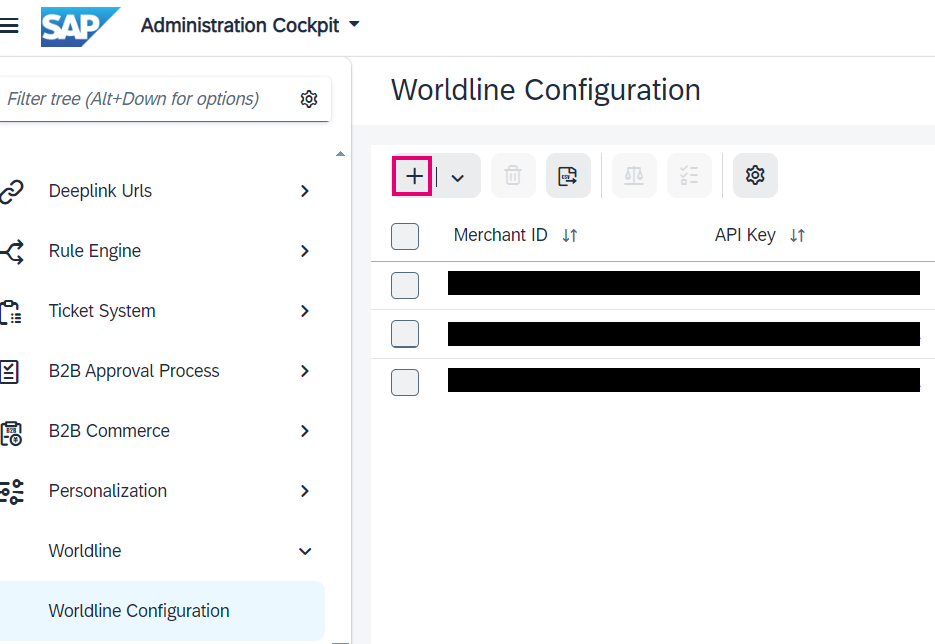
- Enter the following from the table in the appearing pop-window:
| Property | Description/Actions |
|---|---|
| API Key | Enter the API key of your test or live PSPID. Read our dedicated guide to learn how to generate one. |
| API Secret | Enter the API secret of your test or live PSPID. Read our dedicated guide to learn how to generate one. |
| Apply Surcharge |
Confirm choices on whether you want to apply surcharge to your transactions. |
| Ask Consumer Consent | Configure this in the following step. |
| Enforce SCA | Set Enforce Strong Customer Authentication to Yes or No. We strongly recommend setting it to YES to avoid a high rate of declined transactions. |
| Endpoint URL |
The test or live endpoint on our platform. Copy them from our dedicated guide.
|
| SCA Exemption |
Some markets allow you to potentially exempt your customers from a 3-D Secure check. Set Exemption for transactions under 30 EUR to Yes or No. |
| First recurring payment |
Indicate whether to fully charge your customers for the first order in a serious of multiple orders. |
| Grouped cards |
Define whether to group all card payment methods on the Hosted Checkout Page. |
| Split order level promotion to line items |
Define whether your system will attempt to apportion Order Level Promotions across the individual order lines when sending an order to our platform. We strongly recommended YES if you are using order level promotions in your SAP Commerce system. |
| Merchant ID | Enter the PSPID on our platform you want to use for transaction processing. |
| webhookKeyId | Enter the webhookKeyId of your test or live PSPID from the previous step. |
| webhookSecret | Enter the webhookSecret of your test or live PSPID from the previous step. |
Click on "DONE" to confirm your configuration
- Click on the configuration profile in the table you have just confirmed. Enter the following from the table overview:
| Property | Description/Actions |
|---|---|
| OPERATION CONFIGURATION |
If "Operation Code" is set to "Authorization", beware of the following:
|
| TOKENIZATION CONFIGURATION |
|
| 3DS CONFIGURATION |
|
| GROUPED CARDS CONFIGURATION |
|
| RECURRING PAYMENTS CONFIGURATION |
|
| OTHER CONFIGURATIONS |
|
Click on “SAVE” to confirm your configuration.
Configure Base store
Before you start processing (test) transactions, you need to
- Link your Base stores with the plugin configuration.
- Select an integration mode.
To do so, follow these steps and confirm by clicking "SAVE" in each tab:
- Go to Base Commerce > Base Store. Select the store from the table with headers "ID" / "Name".
Select "Worldline" from the available tabs and scroll down to "WORLDLINE CONFIGURATION".
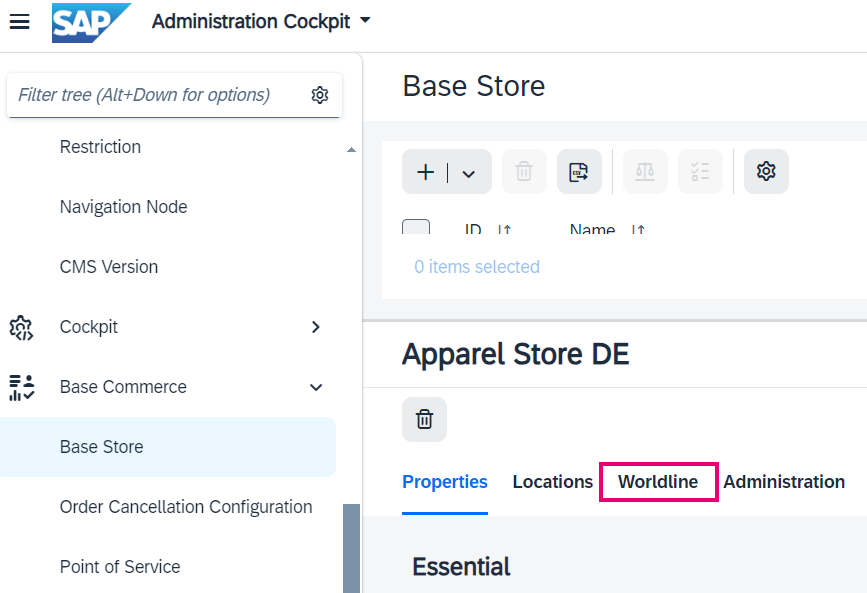
- Enter the following from the table overview:
| Property | Description/Actions |
|---|---|
| Payment Provider Configuration |
Associates your base store with a configuration profile. Click on the field to select the configuration profile you set up in the previous steps. |
| Checkout type |
Select an integration method for transaction processing. Do not switch between checkout modes whilst the site is live, as this might lead to undesirable effects on your customers' payment journey. |
| Checkout type | Description/Actions |
|---|---|
| Hosted Tokenization |
All card brands bundled together in a single iFrame on your checkout page itself via our Hosted Tokenization Page. Read our dedicated guide about Hosted Tokenization Page to leanr more about this integration method. Bancontact is available only on Hosted Checkout Page in QR code mode. |
| Hosted Checkout |
Each card brand listed individually for redirect upon selection to our Hosted Checkout Page. Read our dedicated guide about Hosted Checkout Page to leanr more about this integration method. |
| Merchant Email |
Define the sender e-mail address your customers will receive updates from about updates for to their replenishment orders. |
- Select "ADMINISTRATION" from the available tabs and scroll down to "UNBOUND". Enter "worldlineB2CResponsiveCheckoutGroup" in field "Checkout Flow Group"
- Select "PROPERTIES" from the available tabs and scroll down to "PAYMENT PROVIDER". Enter "Worldline" in field "Payment Provider"
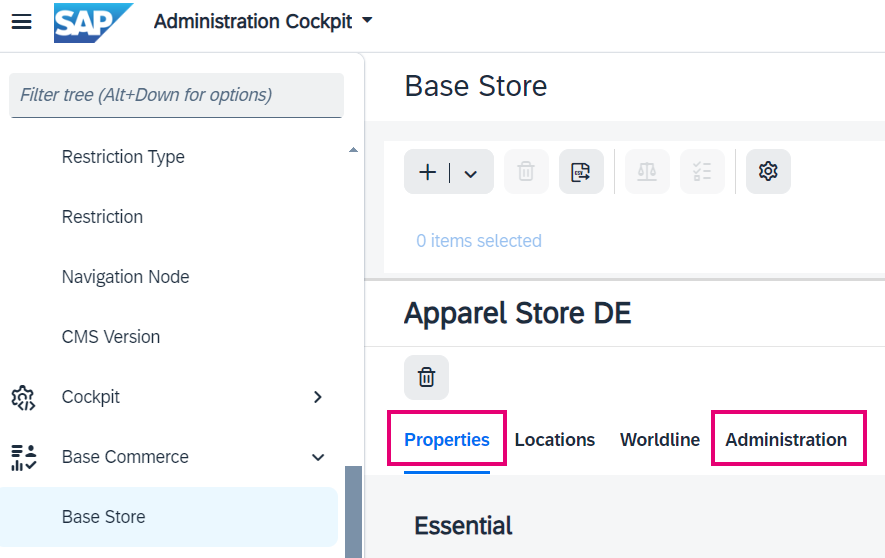
Test connection
Once you have completed all the steps, verify the configuration by establishing a test connection between the plugin and our platform:
- Go to Worldline > Worldline Configuration. Select the configuration profile from the table with headers "Merchant ID" / "API Key".
- Click on "Test connection" in the configuration profile overview. Check that the appearing pop-up window states "OK (success)". If the pop-up window indicates a failed test, contact your system administrator for troubleshooting.
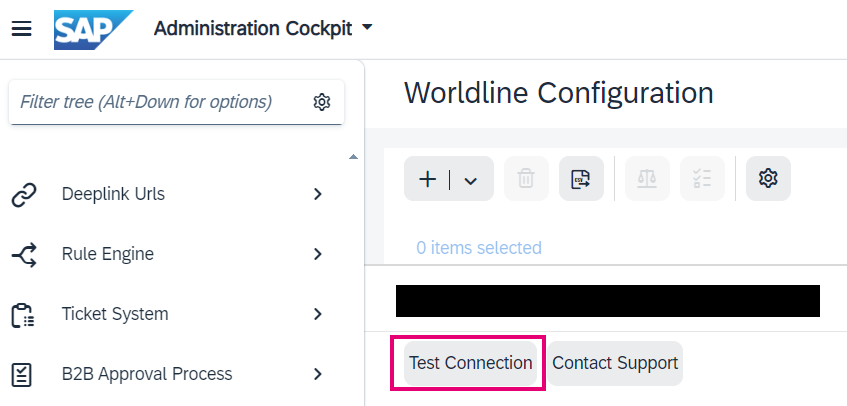
Configure Payment Modes
To configure the list of payment modes, go to Price settings > Payment Modes.
This list shows all available payment methods in your system. (De)activate any payment method by setting the "Is Active" flag accordingly. Once a new payment method has been added to your ANZ Worldline Payment Solutions account, you may have to add in manually. To do so, click on the "+" button on top of the list.
Configure Card On File
To configure Card On File, go to Worldline > Worldline Recurring Token.
This list shows all available tokens for Card On File in your system. Click in the respective line in the table to get a comprehensive overview about the individual token and possible actions:
| Property | Description |
|---|---|
| Token | Unique identifier of the token on our platform. Returned by our platform when creating the token with the first order. |
| Alias | Masked card number linked to this token. |
| Cardholder name | Name of the cardholder linked to this token. |
| Expiry date | Expiry date of the card linked to this token. |
| Subscription ID | Unique identifier of the replenishment order and of the cronjob generating all subsequent orders. |
| Status |
The token's status. Possible values:
|
| Customer |
Unique identifier of your customer who placed the initial order when creating the token. Refer to the Administration tab for more information. |
| Store |
Unique identifier of the store ID managing the replenishment. Refer to the Administration tab for more information. |
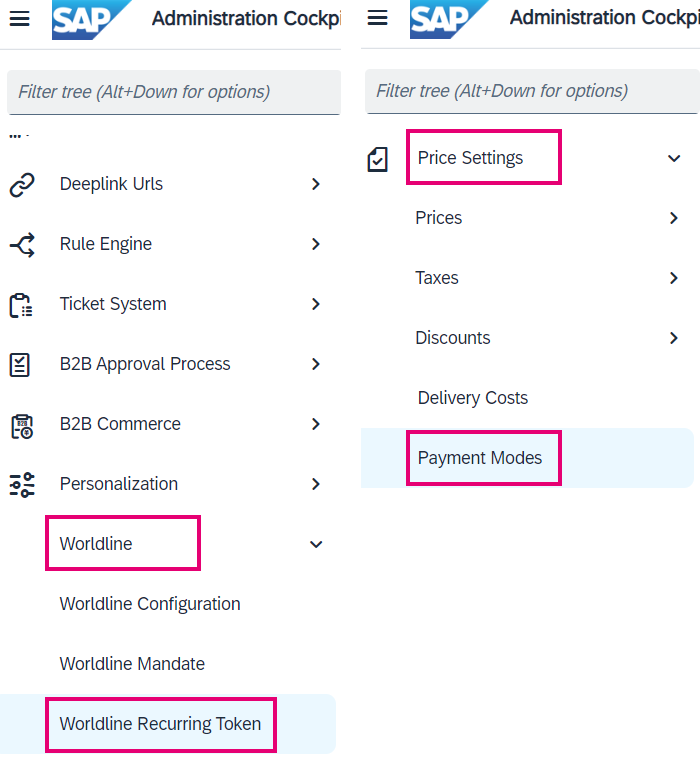.png?language_id=1)
Manage payments
We have designed the plugin to follow-up on your orders automatically and autonomously, freeing you from the administration involved. Learn here how to use our plugin effectively which could help your business to thrive!
Perform maintenance operations
Captures, refunds and cancellations of authorisations are standard processes (also known as maintenance operations) in your everyday business logic. Learn here how to perform these operations in the SAP Backoffice.
Perform test transactions
Use our platform's test environment to make sure your plugin works as intended. We offer test data sets on our dedicated Test cases page. Target our test environment as described in the "Configure Plugin" section.
Make sure to switch to the LIVE environment as soon as you have finalised your tests.